This week I continued with my small mammal surveys and had several capture successes along my transects each night. The most commonly trapped species this week was the Hispid Cotton Rat, which is pictured below. This species usually inhabits tall grass areas where they can have both freedom of movement and a protective canopy, making them perfectly suited to the tall grass pasture where I am currently trapping. This week I also made some final preparations for mesomammal trapping. To prepare the foothold traps for field use after dipping, I have had them buried in dirt for the past few weeks to assure that they no longer have any smell that would alert an animal to their presence. After uncovering all of the traps, I used a trap pan tester to determine pan tension and adjusted each trap accordingly. Since we are aiming to selectively trap coyotes and foxes, each trap needs to have a pan tension that keeps the trap from closing unless two or more pounds of pressure are applied to the pan. When the foothold traps are set at a higher pan tension we are more likely to avoid non-target captures of lighter animals such as skunks and raccoons. Wild Life Intern AnMarie Ulery
Partnership Opportunities
Stiles Farm can run multiple projects at once thanks to the demonstration and research plot model. If you or your company would like to partner with Stiles Farm, we are looking for partnerships in long term conservation tillage and cover crop research, precision agriculture technologies, innovations in beef cattle production, the economics of small acreage horticulture production in the blacklands, and use of Unmanned Aerial Vehicles (drones) in agriculture production.
For partnership ideas, contact Ryan Collett at (512) 898-2214 or rmcollett@ag.tamu.edu.



